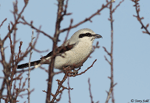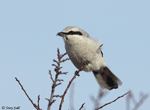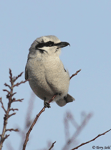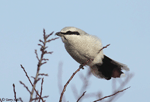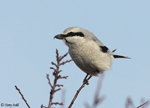| Length: 9 to 10 inches | Wingspan: 14 to 16 inches | Seasonality: Winter |
| ID Keys: Black mask reduced in front of eye, faint barring on underparts, grayish overall | ||
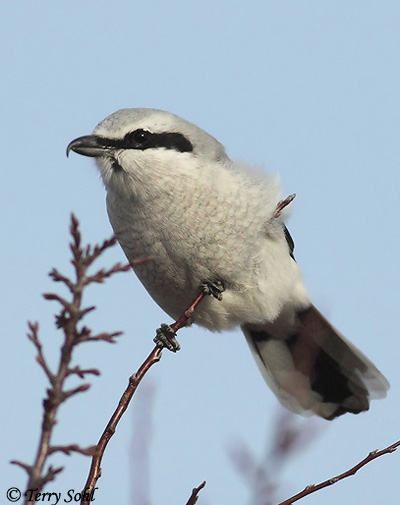 The Northern Shrike is a
winter-only resident of South Dakota, spending its summers in northern Canada
and Alaska. They are very similar in overall appearance to the
Loggerhead Shrike, but differ in
seasonality, as Loggerhead Shrikes are only in South Dakota during the summer
months. A predatory songbird, they will sometimes cache food for later
by impaling their prey on a thorn or barbed wire. They will sometimes
attend feeders, both for suet and for the other birds feeding there.
The Northern Shrike is a
winter-only resident of South Dakota, spending its summers in northern Canada
and Alaska. They are very similar in overall appearance to the
Loggerhead Shrike, but differ in
seasonality, as Loggerhead Shrikes are only in South Dakota during the summer
months. A predatory songbird, they will sometimes cache food for later
by impaling their prey on a thorn or barbed wire. They will sometimes
attend feeders, both for suet and for the other birds feeding there.
Habitat:
Prefers semi-open to open habitat when wintering in the state, as long as hunting perches are available. In the summer, lives in shrubby areas or areas of very open woodland.
Diet:
Feeds heavily on small birds, especially in the winter. Also takes many mice and voles, other small rodents, large insects, and occasionally lizards and snakes.
Behavior:
Feeds by observing from an open perch, and swooping out to capture prey when spotted. Prey is captured in either the bill or the feet, with larger vertebrate prey typically dispatched with a bite to the neck. Prey is often impaled on a barbed wire fence or thorn, with the bird either stashing it for later consumption, or using it to hold prey as it immediately consumes it.
Breeding:
Non-breeder in South Dakota. On their breeding grounds in northern Canada and Alaska, the Northern Shrike builds it's nest in a shrub or small tree, typically between 10 and 20 feet from the ground. The nest is constructed with sticks, roots, and sturdy vegetation, and lined with grasses, down, hair, or other finer materials. The female lays between 4 and 8 eggs, and she alone incubates them. The young hatch after about 15 days.
Song:
The song of a Northern Shrike is a often long sequence of musical notes and phrases, along with raspy shrieks and other vocalizations. Calls include a raspy shriek and a crisp beek.
1Click here to hear the raspy shrieks of a disturbed Northern Shrike, recorded in Washington state.
2Click here to hear a singing Northern Shrike, recorded in Washington state.
3Click here to here varied call notes of a Northern Shrike, recorded in eastern Wisconsin.
Migration:
Summers through Alaska and the northern half of Canada. Winters from coastal Alaska, southern Canada, and the northern 2/3rds of the United States. Also found in Europe and Asia.
Interactive eBird Map:
Click here to access an interactive eBird map of Northern Shrike sightings
Similar Species:
- Loggerhead Shrike - Very similar in overall appearance and structure to the Loggerhead Shrike. The easiest way to differentiate the two species in South Dakota is by season, as Loggerhead Shrikes are here in the summer months, while Northern Shrikes are only here in the winter. The black mask of a Loggerhead Shrike is more extensive than that of a Northern Shrike. The Loggerhead Shrike also lacks the fine barring that is present on the underparts of a Northern Shrike (see photo above).
Feeders:
Will attend feeders for suet, hamburger, and also the other birds you're feeding!!
Conservation Status:
Generally stable throughout it's range, they are found across a broad geographic areas and are common in some areas. The IUCN considers the Northern Shrike to be a species of "Least Concern".
Further Information:
1) USGS Patuxent Bird Identification InfoCenter, Northern Shrike
3) Audubon Guide - Northern Shrike
Photo Information:
March 18th, 2011 - LaCreek National Wildlife Refuge, South Dakota - Terry Sohl
Audio File Credits:
1Andrew Spencer, XC91970. Accessible at www.xeno-canto.org/91970
2Andrew Spencer, XC91967. Accessible at www.xeno-canto.org/91967
3Todd Wilson, XC44981. Accessible at www.xeno-canto.org/44981
| Click on the map below for a higher-resolution view |
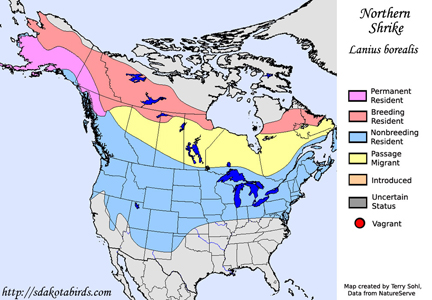 |
| South Dakota Status: Uncommon winter visitor. |
Additional Northern Shrike Photos
Click for a higher-resolution version of these photos
